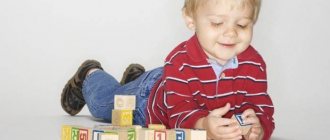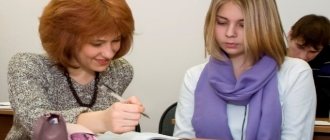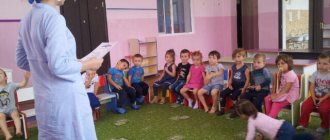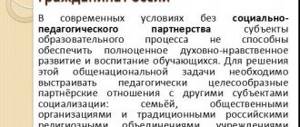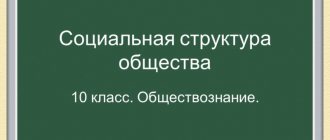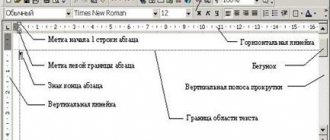Classes in kindergarten are considered the main form of education for children, in which children learn new knowledge and consolidate previously acquired knowledge. Before conducting it, the teacher does a lot of preliminary work - prepares visual material, selects fiction, riddles or proverbs that can be used to attract the attention and interest of children. Also selects didactic games. This is very important because children perceive new material using their senses.
Thinks through the topic of the lesson and the form of the lesson, how to organize the children so that everyone is in the teacher’s field of view, distribute each part of it over time so that the children do not get tired. For this purpose, a change in activity types is used. Even if the lesson is held at tables, then in the middle it is recommended to conduct either physical education or play an outdoor game.
In the article we will look at the types of classes in preschool educational institutions, what forms of organization of children are used, how to attract children so that they accept new knowledge with pleasure and at the same time do not consider classes to be hard work. We will also explain for what purpose educators analyze their classes, what this form of work gives them. You will learn what parts classes consist of, how the educational process differs in the junior and senior groups of kindergarten.
Types of activities
Types of classes in preschool educational institutions have several classifications. If we consider the solution to any didactic problem, then we can distinguish 4 points. These are the following types:
- mastering new material when the teacher explains to the children a topic planned according to the “Education Program”, or new practical skills are developed, for example, in modeling or drawing classes;
- consolidation of previously studied material - repetition of a poem, learned geometric figures or numbers, retelling a familiar fairy tale, didactic game “Name it correctly,” etc.;
- classes in which children use acquired knowledge and skills in the creative process, for example, coming up with the end of a story, making an application according to a plan on a certain topic, coming up with an addition or subtraction problem, completing a sentence, etc.;
- complex is a combination of different types of activities to master one task, for example, when studying the behavior of a squirrel, the teacher suggests guessing a riddle about the animal, looking at a picture, playing the game “What does a squirrel eat?”, listening to a song about this animal, while the teacher will tell about the habits the forest jumper, as she prepares for winter, will give the children the task of counting the number of nuts and mushrooms stored by the squirrel, and at the end will offer to draw the squirrel themselves according to the teacher’s model.
In order to preserve historical memory and in honor of the 75th anniversary of Victory in the Great Patriotic War, 2020 has been declared the Year of Memory and Glory in Russia. The Great Victory came at a high price for our country. We are obliged to preserve the memory of the exploits of the Soviet people and honor it.
Authors: Kavtaeva E. M., Litovsky A. N.
Recommendations for working with the presentation of the thematic lesson “Great Victory in the Unity of the People” for students in grades 9–11
Lesson option [PDF] [DOCX] Presentation [PDF] [PPTX]
Goal: developing knowledge about the meaning and role of the unity of the people in the Great Patriotic War of 1941-1945.
Tasks:
- instilling in students a grateful memory of the people who made an invaluable contribution to the victory in the Great Patriotic War;
- instilling in students a sense of patriotism and civic responsibility;
- developing the ability to express one’s point of view in a reasoned manner;
- formation of humanistic qualities of the individual.
The methodological material is advisory in nature; The teacher, taking into account the characteristics of each class, can vary the tasks, their number, and change the stages of the lesson.
2020 is the Year of Memory and Glory in the Russian Federation. The purpose of it is to preserve historical memory and celebrate the 75th anniversary of Victory in the Great Patriotic War of 1941–1945. We must understand that its time frame is very conditional: the feat of the generation of Victors and the grateful memory of their descendants do not and cannot have a statute of limitations.
Exercise 1.
Analyze the statements of great people and complete the task.
“Always honor the traces of the past.” ( Caecilius Statius , ancient Roman comedian and poet) “A people that does not know its past has no future.” ( M.V. Lomonosov , Russian scientist, encyclopedist, poet, philologist) “Blessed is he who honors his ancestors with a pure heart.” J. V. Goethe , German poet, thinker, philosopher “It is not only possible, but also necessary to be proud of the glory of your ancestors; not to respect it is shameful cowardice.” ( A.S. Pushkin , great Russian poet, writer and playwright) “A people dies when it becomes a population. And it becomes a population when it forgets its history.” ( F.A. Abramov , Soviet writer, publicist, literary critic) “Memory resists the destructive power of time. This property of memory is extremely important. It is customary to simply divide time into past, present and future. But thanks to memory, the past enters the present, and the future is, as it were, predicted by the present, connected with the past.” (D. S. Likhachev, Soviet and Russian philologist, art critic)
1. What idea do you think unites these statements? How do the authors of the statements define the role of historical memory? 2. Using the statements presented, define the term “historical memory”. Historical memory is... 3. Which of the presented quotes is closest to you and why? 4. Look at the pictures and statistics on the slides. Comment on the data.
Task 2.
May 9, 2020 marked the 75th anniversary of Victory in the Great Patriotic War of 1941–1945. The Great Victory has been and remains a leader among events that have been positively perceived by all categories of citizens of our country for decades.
According to the survey “On the attitude of Russians towards Victory Day”, conducted by the All-Russian Center for the Study of Public Opinion (VTsIOM) in May 2020: “The meaning of the parade on May 9, according to 36% of respondents, is so that the memory of the feat of the people is not forgotten ; 30% believe that this is a sign of gratitude to their ancestors; 17% believe that this is a demonstration of military power and another 17% - instilling patriotism among young people. Almost a third of Russians (30%) reported that they heard and participated in the “Immortal Regiment” action (in 2017, this answer was given by 24%); heard, but never participated, 67% of respondents (71% in 2020). 3% of respondents first learned about the “Immortal Regiment” from an interviewer. At the same time, the action itself makes 42% of respondents proud of the country, their fathers and grandfathers, for 21% it is the memory of their ancestors, for 11% it is pain and sadness, for 10% it is joy and happiness, for 9% it is positive and strong emotions, for 8% – tears and anxiety. 95% of Russians who took part in the survey have a positive attitude towards the holding of the Immortal Regiment, 4% have a negative attitude, and 1% found it difficult to answer.”
Read more: Analytical review. Victory Day: attitude and participation.
1. Study and analyze the research data, comment on them. Draw conclusions. 2. How do you feel about Victory Day? 3. Read the statement of the President of the Russian Federation V.V. Putin. How do these words make you feel? 4. What meaning did the head of state put into his statement?
Task 3.
Exceptional dedication, perseverance, genuine love for the Motherland, for Moscow, faith in justice, mass heroism of front-line soldiers and home front workers determined the outcome of the most difficult and bloody war of the 20th century and saved the peoples of the planet from extermination, slavery, and the destruction of national and cultural identity.
1. What place does the Battle of Moscow occupy during the Great Patriotic War? 2. Complete the task via the link. 3. Complete the task via the link. 4. What does the fact of the formation of a people’s militia indicate? What role did the people's militia play in the defense of Moscow?
Task 4.
The friendship and brotherhood of the peoples of the USSR withstood the most severe tests that the Great Patriotic War of 1941–1945 brought. Representatives of all nationalities of our country took part in it.
Representatives of more than 30 nationalities fought to the death in the Brest Fortress. National formations operated near the walls of Stalingrad, showing courage and heroism that knew no national boundaries. And there are a large number of such examples. In memory of those heroic pages of history, a monument “We were together in the fight against fascism” was erected on Poklonnaya Hill in Victory Park. The sculptural composition is one of the attractions of Moscow. The nearest metro station is Park Pobedy.
1. Comment on the data presented in the tables on the slide. Draw conclusions. 2. Read the text. Fill in the blanks in the text. Complete the task via the link or use the QR code. 3. Using contextual knowledge of history, prove that home front workers made a significant contribution to the Victory in the Great Patriotic War.
According to the Ministry of Defense of the Russian Federation, the total human losses of the Soviet Union in the Great Patriotic War amounted to 26.6 million people, of which irretrievable military losses amounted to almost 12 million. Speaking at the Victory Lesson as part of the Moscow International Forum “City of Education” on August 29 – September 1, 2020, People’s Artist of the USSR and RSFSR Vasily Semyonovich Lanovoy said: “We must preserve the memory of the Victory for future generations. The price of Victory is millions of lives of our soldiers and civilians. I look with deep emotion at the faces of the guys who want to understand what kind of courage was needed to defend our Motherland. I myself remember the war - on June 22, 1941, my sisters and I came to my grandfather in Ukraine and saw hundreds of German planes in the sky, flying to bomb Odessa. I saw the first Soviet partisan detachments in 1944. We are obliged to preserve the memory of the exploits of our people and honor it. The day will come when the last participant in the war will be gone. But we will stand up and carry their portraits, let everyone see their faces - we are their heirs. The “Immortal Regiment” movement, of which I am a co-chair, has grown and is spreading all over the world.”
Task 5.
The official website of the Ministry of Defense of the Russian Federation contains a unique project “Road of Memory”, designed to perpetuate the memory of participants in the Great Patriotic War.
The multimedia museum complex "Memory Road" 1418 steps was erected on the temple grounds of the Main Temple of the Armed Forces of Russia for a significant date - the 75th anniversary of the Great Victory.
Study the materials of the “Memory Road” project.
1. Explain what makes this project unique. 2. Guess what the mission of everyone who decides to take part in the “Road of Memory” project is.
Task 6.
The Great Patriotic War is moving further and further into the great historical past.
“There are fewer and fewer veterans, and the youngest are already over 90 years old. This poses serious challenges for us to provide social support to veterans. We are talking not just about some kind of cash payments, but about targeted, individual work with each veteran.” ( Sergei Sobyanin , Mayor of Moscow)
Task 7.
Using the link, study the data on the number of disabled people and veterans of the Great Patriotic War, persons equivalent to them and family members of deceased (deceased) disabled people and war participants living in the Russian Federation.
Data from the Pension Fund of the Russian Federation as of April 1, 2020
1. What can society and each individual citizen of the country do in order to prolong and improve the lives of the above-mentioned categories of Russians? When answering this question, you can use the information posted on the official website of the Moscow Mayor.2. Are you ready to join these support programs?
Task 8.
The year of memory and glory in the Russian Federation continues.
In 2020, a garden of memory was laid out in Moscow and the regions of the Russian Federation on the Day of Remembrance and Sorrow. “By uniting the whole country and going beyond the borders of 50 countries, we have almost achieved our goal - to plant 27 million trees in memory of the 27 million who died during the Great Patriotic War. And this is not surprising, because the war did not spare a single family. Each of us has our heroes." ( Victoria Abramchenko , Deputy Prime Minister of the Russian Government)
Study the materials on the official website of the Year of Memory and Glory in the Russian Federation.
1. What events will take place as part of the Year of Remembrance and Glory from September to December 2020? 2. Which ones would you like to take part in and why?
Task 9.
Read the lines of Rasul Gamzatov’s poem, look at the images on the slides.
Complete the task.
1. How do these lines make you feel? 2. What meaning did the author of the poem put into his work? 3. Why are the lines of this work famous in the Russian Federation and throughout the world? 4. Get to know the Rzhev Memorial website. What unites the history of its creation and the topic of today's conversation? 5. On July 1, 2020, a nationwide vote took place on amendments to the Constitution of the Russian Federation. Read article 671. paragraph 3. What role does its appearance in the basic law of the country play?
Full text of amendments to the Constitution of the Russian Federation
Classification by content of knowledge
Other types of classes in preschool educational institutions can be divided according to the content of the knowledge gained. This can be a classic lesson when the children study the planned section of the program. It can be divided into several stages:
- explanation of a new topic;
- consolidating the material with questions on the topic or completing an assignment;
- summing up the work.
Another type of organization of the educational process in kindergarten is called an integrated lesson. What type of classes is this at a preschool educational institution? Let's look at this with the following example. For example, the teacher raises the topic “Sea”. Children discuss the composition of sea water, transport that moves on the waves, who lives in the depths of the seas, what grows in the water, what the bottom is covered with, how people relax at sea, what kind of entertainment there is on the water, etc.
The topics of classes in a preschool educational institution can be chosen as specific, for example, some kind of natural phenomenon, holiday or hero of a fairy tale, or general ones - a store, a forest, a bakery. In the first option, children receive expanded knowledge about something specific, and in the other, an understanding of the holistic picture of the work of an enterprise or store, the life of the forest, etc. is formed.
Thematic lesson “Getting to know” children (5-6 years old)
The teacher reminds the children that we communicate with different people in different ways: “Say hello the way you greet:
-with a friend in kindergarten
-with the teacher
-with a clown in the circus
- with my beloved grandmother
- with someone who was offended
- with someone you are glad to see
Now let’s all say together: “Hello!” and let's applaud each other.
Game "Cooks"
Everyone stands in a circle - this is a saucepan. Now we will prepare the soup (compote, vinaigrette, salad). Everyone comes up with what it will be (meat, potatoes, carrots, onions, cabbage, parsley, salt, etc. The teacher hands out pictures.
The teacher shouts out in turn what he wants to put in the pan. The one who recognizes himself jumps into the circle, the next one, jumping, takes the hands of the previous one. Until all the “components” are in the circle, the game continues. The result is a tasty, beautiful dish.
Collective work “Flower meadow of FRIENDSHIP”
A blank clearing hangs on the board. Flower preparations are laid out nearby.
Teacher:
- Guys, will you help Umnyasha and me plant beautiful flowers in the clearing of FRIENDSHIP? Look what flowers we have?
Ushastik:
- Choose the one you like best. Let's take turns. Dasha, take a flower, glue it and draw a stem for it, please. This is the flower Dasha planted! Who, Dasha, will you give the felt-tip pen to? (children take turns gluing flowers)
Psychologist:
- Amazing! We have a very beautiful clearing of FRIENDSHIP!
Game “Blow up, bubble!”
Teacher:
— Guys, do you want to know Umnyasha’s favorite pastime? He will tell you in your ear (Umnyasha speaks into the first child’s ear, and then the children in a circle repeat his words into each other’s ears).
And then we will all say in unison what kind of activity this is
(“Blowing soap bubbles”).
-Come on, let’s also blow soap bubbles (the teacher blows soap bubbles, the children catch them).
Game "Ha-ha-ha! He-he-he!"
Children stand in a circle, clasp their hands. The presenter shows the following:
-Touches left shoulder 3 times, saying “ha-ha-ha”
-Touches the right shoulder 3 times, saying “ho-ho-ho”
-Touches left knee 3 times, saying “hee hee hee”
-Touches the right knee 3 times, saying “he-he-he”
Then all movements are repeated at a faster pace 2 times. Then even faster, 1 time at a time. Then the number of times increases and the pace decreases. By saying the last “heh,” children are invited to throw out all the fatigue, all the anger, all the resentment that has accumulated in their body.
Teacher:
It’s time to say goodbye, but now we will have such a ritual (tradition) that before we go home, we first stand in a circle, stretch out our left hand “from the heart, from the soul” (it turns out to be a pyramid of palms) and say the traditional words: “ One, two, three, four, five – we’ll meet again soon!”
Components of a classic lesson
The structure of classes in preschool educational institutions is divided into 3 main parts, each of which has its own purpose.
- Preparation or organizational moment. The attention of preschool children is still difficult to switch from one type of activity to another, so time is needed for the children to calm down, tune in to the lesson, and concentrate on the teacher and what the teacher is talking about. This is achieved by using a calm voice and including a playful moment, for example, a squirrel came to visit the kids and wants to tell a story that happened to it. At the same time, a bright toy appears in the teacher’s hands. It attracts the attention of children, they are already ready for the lesson material.
- Main part. If the initial stage lasts only a couple of minutes, then this component of the lesson is the longest, taking from 7 to 20 minutes, depending on the age group of the kindergarten. During this time, children gain new knowledge and consolidate it in practical activities or by completing the teacher’s tasks orally.
- The lesson ends with a summary of the work, how they completed the task, and an analysis of the children’s work is carried out, if there was visual activity. Be sure to celebrate the active work of the children and tell them what they will do next.
Thematic classes. What is the advantage of the approach?
I have been searching for the answer to this question for 10 years, 3 of which were spent conducting research. It was this that was presented to the academic council of the pedagogical university during the defense of my dissertation. Looking ahead, I will say that I received not only excellent results, but also applause!
But let’s return to the question of what thematic activities are and why they are so effective in the development of children.
“What does your typical play look like with a 2-6 year old child?” — I asked every mother this question at the initial stage of the study.
The answers were very different, but close to each other:
- we build something together, then I leave, the child continues
- we set the table with doll dishes and have tea parties or put the doll to sleep, in a word, we play daughter-mother
- we drive cars from morning to evening (so tired of them), and we also build garages from scrap materials
- we try to act out performances with the help of dolls, but not always successfully, I also offer workbooks, but there is little interest in them
- I don't know how to play, I'm bored!
This is the phrase I came across most often. There are two key words here: “boring” and “I can’t.” When mom is bored, the child is unlikely to support her suggestion of a game because he feels a lack of interest. The truth feels!
Thematic activities make the play life of mother and child brighter and more interesting, and even easier (the question of “I don’t know how to do it and being bored” disappears by itself!).
- There's always a game plan
- Each lesson introduces the child (and not only him) to something new and surprises
- It is always action, immersion, getting used to the role of mother and child.
- This is the rapprochement and establishment of a strong mother-child bond
- The thematic activity has no spatial boundaries and you can continue to play and develop not only at home, but also on a walk, on a trip, or while standing in line. The main thing is to know what to do

